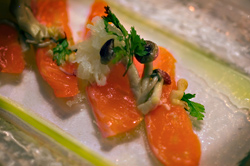It’s rare that a restaurant wins me over with a salad. I only order it because my superego requires some token to counterbalance the butter I’m mainlining. But Coupage‘s mâche salad was more a landscape than a pile of greens: a foot-long hedgerow of tangled leaves, the plush growth contained on one end by a clump of smoked maitake mushrooms and on the other by tiny, conical bamboo shoots. Mâche (also called lamb’s lettuce) is about as delicate a green as you’ll barely taste, but chef Rachel Yang tosses it in a truffle-soy vinaigrette—and just enough to tickle the nose, not bludgeon it. The hint of truffle aligned the flavor of the greens with the leather and tobacco of the smoked mushrooms and Camembert-funk of the bamboo shoots. The salad was Asian meets European, New York meets Seattle, and not too conceptual to taste great.
Calling one’s cuisine “Korean-French,” as this two-month-old Madrona restaurant does, is like wearing a Comme des Garçons dress to a Seattle . . . well . . . anything: ambitious enough to come off as audacious. There are many ways to screw up the blending of Asian and Western cuisines—and I’ve tasted most of them. And while Korean and fancy French restaurants are two of my favorite dining experiences, the radically different flavors they embrace don’t make for an intuitive pairing.
Yet there’s no other new restaurant I’ve been more eager to try than this one. Call me a starfucker: Yang’s résumé includes two Michelin three-star names in New York: Per Se (whose chef is Thomas Keller) and Alain Ducasse’s Essex House. Essex House is where Yang met her sous-chef, Seif Cherchi; afterward, she tested out her Korean-French approach at the short-lived D’Or Ahn in Manhattan. Then restaurateur Thomas Hurley brought Yang and Cherchi to the West Coast. Also a former New Yorker, he had moved to Portland in 2003 to open Hurley, a restaurant whose East Coast fussiness/elegance (you pick the adjective that best fits your tastes) pissed off some Oregonians and won many more over. Now he’s set out to do the same to Seattleites.
While some aspects of Coupage haven’t coalesced, Yang’s food is as intriguing and delicious as I’d hoped. Also, it was pretty. Every plate that came my way was meticulously arranged: The arctic char, smoked over pine needles, was sliced into six peach-colored squares, each the base for a dab of grated daikon, a micro-sprig of frilly chervil, and sweetly pickled honshimeji mushrooms the size of thumbtacks. A 2-inch chèvre “cheesecake” was ornamented with apples, scooped with a melon-baller and poached in red wine so they resembled ripe Bing cherries.
The flavors that came through were deeply felt rather than concocted, enlivened by Yang’s wit. The original bi bim bap is as homey as it gets: a big stone bowl heaped high with rice, meat, vegetables, and egg. Yang’s bi bim bap, by contrast, was a saucer-sized bed of rice with a vegetable-mushroom slaw covering its surface. The rice was set on an 18-inch ceramic oval, and a line of chili sauce ran from one end of the plate to the other, interrupted by a tiny soft-boiled quail egg. Her short ribs were not grilled or served on the bone but rather a meatless cube of braised beef that looked almost like a piece of chocolate cake, topped with kimchi made with Brussels sprouts instead of cabbage.
It didn’t all work. Even typing “romaine salad with black sesame ranch dressing and bacon,” I get curious anew about what the salad was supposed to be like. What I tasted—chopped lettuce with a little pork on top—held no mystery, and no dressing. The branzino with lemon confit “kimchi” style should have been great; but the pan-roasted fish fillet was propped up by diced zucchini above a lake of some bland puree that sucked away the power of the preserved lemon-relish and fermented black bean sauce.
But there was so much polish in evidence—in a salade niçoise reworked into beautifully cooked ahi over a bed of haricots verts with a fantastic caper-parsely-anchovy pesto around the bottom, or in a rice pudding perfumed with cracked black pepper and candied kumquats—and Yang’s vision is so distinctive, every item on the menu made me itch to try it.
Loved the food. Hated the setting. Perhaps it’s just winter, but the room feels cold and stiff. The walls and carpet are the deepest shade of blue gray, as if you’re dining at the heart of a glacier. Ensconced in the booths around the edges, you can ignore the chill, but not when you’re adrift at the too-small tables in the center. Then there’s that mural, someone’s middlebrow fantasy of how the moneyed class party (hint: It involves clinking glasses and “joie d’esprit”). The service is also still finding its tone; the front-of-house manager was keen on little details, and the supporting staff didn’t once flake out, but our server kept arriving three beats too early or too late, and it felt like she was embodying the self-conscious formality of her surroundings.
I have to leave you with one last dish—again, a salad. Hidden amid the heap of greens in the two- or three-person “chef’s salad,” like Easter eggs in the park, were little treats: A slim slice of seared foie gras. Crisped-up slabs of pork belly. A small lobe of perfectly cooked sweetbreads. Golden “croutons” of breadcrumb-coated marrow, which crackled and gushed on the tongue. Every meat, in short, my little id desires.






